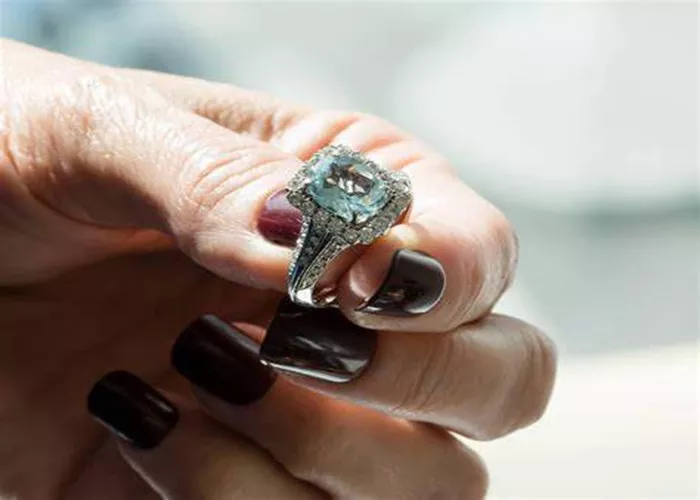Aquamarine, with its captivating ocean-blue hues, has long been cherished in fine jewelry. A 3-carat aquamarine ring makes a particularly stunning statement – substantial enough to command attention yet versatile enough for daily wear. Whether you’re considering it as an engagement ring alternative, a milestone gift, or a personal indulgence, understanding pricing factors will ensure you make a wise investment.
Understanding Aquamarine Value Factors
The price spectrum for 3-carat aquamarine rings is remarkably broad, ranging from about 2,000toover30,000. This wide variation stems from several critical quality determinants that every buyer should understand.
Color: The Most Critical Value Factor
Aquamarine’s value hinges primarily on its color saturation and tone:
- Top Grades (“Santa Maria” and “Espirito Santo”): These display an intense, pure blue reminiscent of tropical waters. Stones from Brazil’s famous Santa Maria de Itabira mine command premium prices, often 3,000−6,000 per carat.
- Medium Grades: Softer blue tones, sometimes with very slight green undertones, typically range 800−2,500 per carat.
- Commercial Grades: Pale blue or noticeably greenish stones may be priced as low as 300−700 per carat.
Pro Tip: View stones under both natural and artificial light. The best aquamarines maintain their color consistency across lighting conditions.
Clarity Standards for Aquamarine
Unlike many gemstones, aquamarines are valued for their eye-clean clarity:
- Premium Quality: Completely inclusion-free to the naked eye, even under 10x magnification.
- Commercial Quality: May contain minor visible inclusions, typically liquid “fingerprint” patterns.
Interestingly, some collectors prize rare specimens with unique inclusions like “raindrop” patterns, though these are exceptions to standard valuation.
Cut Quality and Shape Premiums
Cut quality dramatically affects aquamarine’s beauty and value:
- Excellent Cut: Precise faceting that maximizes brilliance and color intensity (adds 15-30% value).
- Popular Shapes: Ovals and rounds command slight premiums (5-10%) due to higher rough loss during cutting.
- Specialty Cuts: Designer cuts (e.g., Portuguese, checkerboard) may carry 20-30% premiums for artistry.
Ring Setting Considerations
The mounting choice can double (or triple) your total ring cost:
Metal Options Compared
| Metal Type | Durability | Price Range (3ct setting) | Best For |
|---|---|---|---|
| Platinum | Extremely durable | 2,500−6,000 | Heirloom pieces |
| 18K White Gold | Good durability | 1,800−4,000 | Classic looks |
| 14K Gold | Good value | 1,200−3,000 | Budget-conscious buyers |
| Palladium | Hypoallergenic | 2,000−4,500 | Sensitive skin |
Design Complexity Costs
- Solitaire: 800−2,500
- Halo Setting: 1,500−5,000
- Three-Stone: 2,000−6,000
- Custom Design: 3,000−10,000+
Market Trends Affecting Prices
Recent developments in the gemstone market are impacting aquamarine pricing:
- Brazilian Export Restrictions: Reduced supply from traditional mines has pushed up prices for top-color material by 12-18% since 2022.
- African Discoveries: New finds in Mozambique and Nigeria offer more affordable alternatives, though with slightly different color profiles.
- Lab-Grown Competition: While not yet widely available, lab-created aquamarines are beginning to affect the lower end of the market.
Smart Buying Strategies
To ensure you get the best value:
- Seasonal Buying: Prices often dip 10-15% in February/March as jewelers clear inventory before the spring buying season.
- Loose Stone Advantage: Purchasing a loose gem (saving 20-40%) then having it set locally can offer significant savings.
- Certification Matters: GIA or AGS reports add 10-15% to value but provide crucial quality assurance.
Long-Term Value Considerations
While aquamarines don’t appreciate like some gemstones, quality pieces hold value well:
- Top-color stones have shown 4-6% annual value increases over the past decade.
- Designer pieces from houses like Tiffany or Cartier often command significant premiums at resale.
- Period styles (e.g., Art Deco mounts) can substantially increase collectibility.
Care and Maintenance Insights
Proper care ensures lasting beauty:
- Cleaning: Ultrasonic cleaners are generally safe, but steam cleaning should be avoided.
- Wear Considerations: Remove during vigorous activities – while durable, aquamarine can chip from sharp blows.
- Recutting Possibilities: Well-cut stones can often be re-polished decades later to restore brilliance.
Conclusion
For different budget levels:
- 3,000−6,000: Focus on color quality in a simpler setting
- 8,000−15,000: Balance excellent color with a better setting
- $20,000+: Seek collector-quality stones with designer settings
Remember that the most satisfying purchases balance quality with personal significance. A slightly smaller but finer colored stone often brings more lasting pleasure than a larger but inferior one.
By understanding these detailed factors, you’re now equipped to navigate the aquamarine market with confidence, ensuring your 3-carat treasure will be a source of joy for generations to come.
Related Topics:
- What is Aquamarine Rose?
- The Timeless Elegance of a Diamond and Aquamarine Eternity Ring
- What is The Price of Aquamarine Per Carat?


